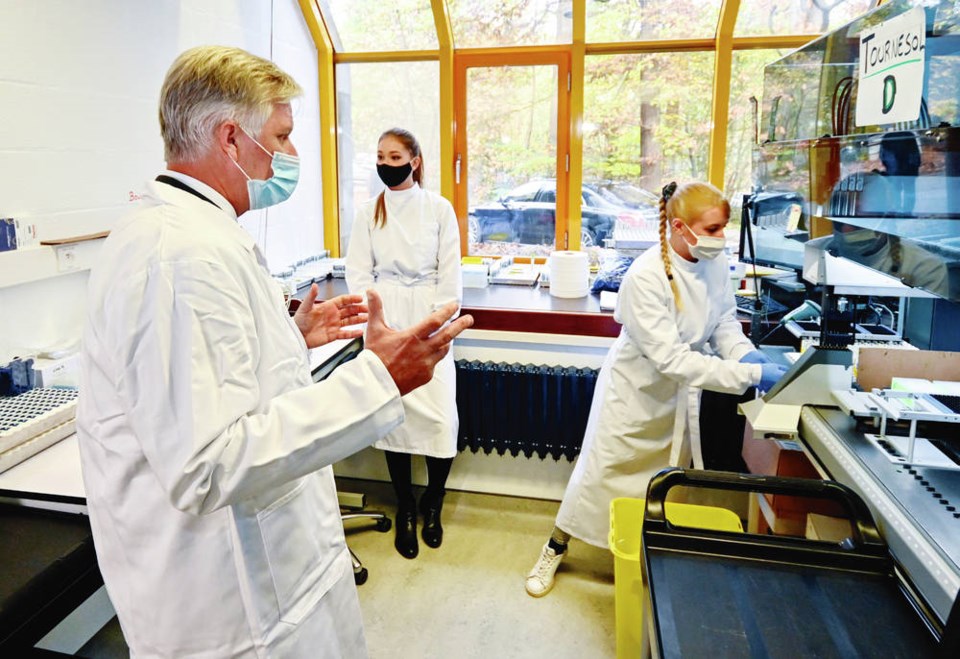A dog living with humans infected with COVID-19 in Ontario recently tested positive for the virus. Infected dogs have been reported in other countries, but this is the first confirmed case of a COVID-19 pooch in Canada.
Lab studies have shown that cats, too, can catch the virus. Like dogs, cats rarely show symptoms and typically recover within about a week.
In these cases, humans passed the virus to the cats and dogs. To date, little evidence exists that Felix or Rex can return the favour. Nonetheless, researchers, vets and health officials urge caution – too little is known about the virus to be certain. As for COVID-19 in minks, it may move both ways, although that remains to be confirmed.
Many viruses and microbes spread between species. Of the five or more new viral diseases that emerge in humans every year, about three-quarters typically originate in animals.
In fact, an international team of biologists, ecologists and disease experts reported last month that mammals and birds host from 540,000 to 850,000 viruses that could potentially infect humans.
COVID-19 itself is thought to have originated in bats. It is genetically similar to a coronavirus found in Asian horseshoe bats.
But researchers think another species played an intermediary role before the virus spread to humans. A four per cent difference between the genomes of the COVID-19 virus and the bat virus represents 50 years of diverging viral evolution. The result of those 50 years in a mystery host is a virulent microbe that has, to date, killed almost 1.2 million people worldwide and sickened almost 46 million others.
As for other devastating viral human diseases from other animals — the SARS coronavirus was transmitted from civet cats to humans, and the coronavirus that causes Middle East respiratory syndrome jumped to humans from dromedary camels. Here, too, bats may have been the original reservoir species.
The chimpanzee version of HIV likely crossed to humans when humans hunted chimpanzees for meat and came in contact with their infected blood.
African fruit bats may be involved in the spread of Ebola and may even be the source animal.
A study of dozens of measles genomes earlier this year suggests the measles virus diverged from a closely related cattle virus more than 2500 years ago, at about the time the first large cities were being established.
Rabies, Zika virus and West Nile virus are other examples.
And then there are bird flu and swine flu — although it now seems swine flu may actually be a variant of bird flu that has detoured through pigs.
The 1918 influenza pandemic, which claimed 50 to 100 million lives, was believed for decades to be a swine flu. But a 2014 analysis of more than 80,000 gene sequences from flu viruses isolated from humans, birds, horses, pigs and bats revealed that the genes of the 1918 pandemic virus – a strain of the H1N1 flu virus — originated in birds and that it likely sprang directly from North American domestic and wild birds.
Mallard ducks are the primary animal reservoirs of H1N1 influenza viruses, with as many as 60 per cent of mallards infected with H1N1 in any given year.
The first cases of flu in the 1918 pandemic were recorded in the U.S. American soldiers who were infected with the virus shipped to Europe to fight in the war. Once there, poor sanitation and hygiene were notoriously difficult to maintain near the frontlines, and soldiers were housed in close quarters. The conditions allowed the virus to spread among people and into local waterways where mallard ducks roosted.
As an added twist, Europe’s weather during the last years of the First World War may have increased the amount of flu virus in the environment and heightened exposure risk, as well as weakened the immune systems of people in the region. Bad weather disrupts ducks’ migration patterns, and the incessant rain and cold along the Western Front in 1917 and 1918 may have kept many birds carrying the deadly virus hunkered down along western Europe’s ponds, rivers and streams.
There, they would have carried on pooping live flu virus into the water that stressed, exhausted and poorly fed soldiers and civilians used for drinking, cooking and washing up.
As we’ve seen with the spread of COVID-19, no self-respecting virus can turn down an opportunity for world domination like that.



